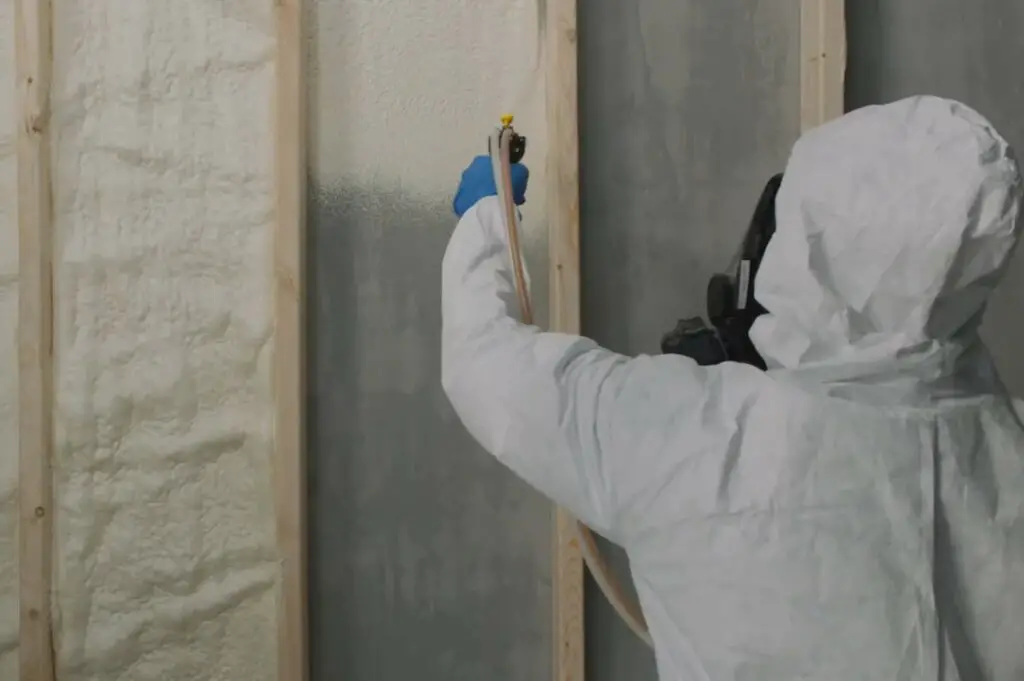Spray Foam Insulation: Introduction for Homeowners
By Rose Morrison • Published August 29, 2024
Reviewed by Jack Gray, Roof Online Editor

Table of Contents
Contractors, roofers, and homeowners know insulation is only one aspect of the home, but it is monumental enough to influence the building’s life. Spray foam insulation (SFI) is an industry staple for a reason — its thermal performance, energy efficiency, and cost-effectiveness make it a serious option for the building envelope.
What Are the Ingredients in Spray Foam Insulation?
Industry experts are more than familiar with the essential components of SFI, including polyol resin and isocyanate in most cases. They are the foundation and reaction, with other ingredients giving SFI additional characteristics, such as:
- Blowing agents: Incorporations like hydrofluorocarbons, hydrocarbons, and water that promote expansion
- Catalysts: Ingredients that speed up and kick-start the foaming reaction
- Surfactants: Ways to make SFI structure and texture more stable
- Flame retardants: Increases in fire resistance and safety
- Coloring agents: Indicators for aesthetics or to distinguish unique types of SFI
SFI has several umbrella categories, including open- and closed-cell foams. Open-cell foams have more air pockets and lower density on average, giving moisture and air more flexibility in where they travel. Alternatively, closed-cell foams are denser, having higher efficiency — or R-values — that make them structurally sound and more impermeable. There are also lesser-used medium-density foams, which have higher average R-values.
These are SFI characteristics, but the modern research landscape is innovating. Sparked by sustainability conversations and resource use, bio-based polyols and blowing agents with lower global warming potentials are strong contenders to become market-viable in the near future. These renewable, organic compositions include cellulose insulation that is naturally resilient to wear and tear and environmental stressors, including heat and fire.
What Should Contractors Anticipate When Using It?
Usually, workers apply SFI in one of two ways. There are one- and two-component systems. The former is a premixed formula that shapes as the contractor installs it. The latter requires a spray gun, which mixes the ingredients as they exit the various nozzles. This is more involved and requires the following steps:
- Preparing the surface area to cover in insulation, making it dry and clean
- Mixing the SFI ingredients with the right ratios
- Waiting for the mixture to expand
- Waiting for it to cure after application, as it hardens in several seconds depending on the mix
The specs for SFI vary based on the cell structure. Typically, R-values — which describe how well it resists heat traveling through the walls — range. Characteristics such as density, permeability, and thermal performance are unique to each SFI type.
| Quality | Open-Cell | Closed-Cell |
|---|---|---|
| R-Value | Around R-3 and R-4 | Around R-6 and R-7 |
| Water Resistance | Can absorb moisture | Does not absorb water |
| Density | Lower | Higher |
| Compressive Strength | Under 5 psi | 25 psi or higher |
| Vapor Permeability | Breathable | Vapor barrier |
| Installation Time | Seconds | |
| Acoustic Absorption | Higher | Lower |
| Thermal Performance | Medium | High |
| Fire Resistance | Class 1 or Class A | |
| Pest Deterrence | Effective | |
How Safe Is Spray Foam Insulation to Install and Live With?
SFI is contentious among homebuyers and contractors because of its safety concerns, the U.S. Environmental Protection Agency cited in 2020. The particulates seep into the air, and without proper personal protective equipment, contractors may unintentionally inhale insulation they cannot see.
Isocyanates irritate the skin and respiratory system, so full-body suits, safety goggles, gloves, and respirators should be the minimum expectation. Insulators may take additional precautions by having as much ventilation as possible, even by opening windows or using exhaust fans.
The curing process is another deceptive yet potentially hazardous process. SFI will be fully set within 24 hours and off-gas during this time. Volatile organic compounds (VOCs) will enter the air in high concentrations, making it unwise to remain in the area after installation. Off-gassing is temporary, and many new SFIs contain low to no VOCs because of environmental and health awareness.
However, this does not mean long-term air quality compromises are not still top of mind for residents and professionals. Prolonged exposure to curing or poorly installed SFI can lead to breathing conditions like asthma or chronic skin care allergies or sensitivities.
Preventing this requires professionals to have certifications from training programs following updated manufacturer and compliance guidelines from entities like OSHA. They must also ventilate the area well afterward, conducting regular inspections on the structural integrity and air quality as necessary.
Can Homeowners Install Spray Foam Insulation Themselves?
Hiring an expert is expensive, and if all homeowners need is a mask and spray nozzles, why not let them take care of the job?
Safety and Lack of Training
It is not recommended for most people to DIY SFI installation because of the hazards. Some households may have the equipment to do everything safely, but this is uncommon. Insufficient training is another concern, as proper application requires technical knowledge the average handyperson may not have access to.
Compliance
Inspectors may have bad news for prospective buyers if the house goes on the market after a DIY insulation installation job. If there are safety issues, it could cost homeowners more to have it redone during the selling phase. It can cost between $2.75 and $7.50 for every square foot, totaling thousands per room.
Financial Considerations
DIYing is enticing because of the cost savings, but investing in a professionally trained contractor may be worth eliminating the long-term health care risks. If installed incorrectly, homeowners may also lose money, as they spend more on energy bills because of air pockets or structural gaps.
Longevity
A DIY effort may not have access to professional-grade ingredients or equipment, primarily when kits are easy to come by. Even if the individual knows everything they must about SFI, the quality of machinery and insulation could hinder the insulation’s life span.
How Does Spray Foam Insulation Impact Property Value and Warranties?
A DIY insulation job could impact the property value of the house if poorly administered. However, if the homeowner does a good job or has an expert put in high-quality SFI, it could help with the resale value. Unfortunately, there could be warranty ramifications despite this good news.
First, the presence of SFI alone is causing panic for many seeking mortgages. Some
Banks across the world recognize the risks associated with it, and it is a trend to reject applications for homes with this material.
Some asphalt shingle manufacturers do not want their products supported by SFI and have the right to void warranties if it is sticking to the underside of the roof deck. They may or may not be transferable if homeowners want to sell. Workmanship and installation warranties can range from five to 20 years, depending on the company, but homeowners and installers alike will need to verify the fine print before committing to SFI.
Eco-aware buyers may also have reservations about SFI being in their future homes. While its efficiency could lead to reduced energy consumption, the air-polluting nature, and waste generation concerns from installation may be a red flag for buyers. Additionally, if they wanted to replace SFI, nonbiodegradable options would need to go to a landfill. In the future, more may default to recycled panels.
Other Frequently Asked Questions
A few more FAQs roofing experts get asked by homeowners.
1. What Other Considerations Do Homeowners Need to Remember With Roofing?
The roof’s insulation, absorption, and reflection needs may impact your decisions about the materials used. For example, a black roof averages between 140 and 190 degrees Fahrenheit, whereas a green roof with vegetation is around 90 degrees. A painted metal roof averages 105-115 degrees, while a white roof falls within the 102-120 degrees range. Whatever the average roof temperature, spray foam insulation must be applied on the roof at an exact temperature and this is different to ambient air temperatures, which makes working with professional roofers preferable.
2. Is Spray Foam Insulation (SFI) the Same as Spray Foam Roofing (SPF)?
Spray foam insulation and spray polyurethane foam (SPF) roofing are both typically created by using isocyanate and a resin mix (1:1 ratio). Roofing foam is just heavier because of the amount of resin added to the SFP formula. Both SFI and SPF have opportunities for application error, and temperature restrictions when installing. The main difference between spray foam insulation is that it is lighter and less dense than SFP. Although both types are considered closed-cell, you do get spray foam insulation contractors who utilize lighter foam, impacting R-Values. Spray foam roofing also costs more and there is an over spray potential.
Conclusion
SFI became a go-to resource because of its versatility and ease of installation. It fits into crawl spaces and attics equally well, with high environmental resistance, and energy efficiency. Contractors and DIY enthusiasts are only making SFI more eco-conscious and safe for households. Additionally, its properties will improve as new materials bolster its heat and moisture management potential. Moving forward, all installers should use innovative solutions to introduce buildings to the next generation of SFI.
About the Author

Rose Morrison is the managing editor of Renovated.com. She is a skilled researcher and specialty writer passionate about better building, construction, maintenance, and roofing. She regularly contributes to reputable sites like ISHN, The Safety Magazine, and Energy Central. Connect with Rose on LinkedIn.